Friday, 15 April 2011
Friday, 8 April 2011
Evaluation
In what ways does your media product use, develop or challenge forms and conventions of real media products?
One of the ways we challenged the conventional codes of the thriller genre was by the gender of the victim. We used a male, which challenges the old convention of some thrillers, such as Psycho (Alfred Hitchcock, 1960), where the victims are generally female and portrayed as helpless and their only hope of safety comes in the form of a male hero, ready to “dash to their rescue”.
 An example of how we used the conventions of real media products would be the classic convention of the thriller form which is the use of antagonists and protagonists. This theme runs through most thrillers, like Reservoir Dogs (Quentin Tarantino, 1992), for example, where there are definite antagonists and protagonists - Mr. Blonde, a psychotic thief, and Mr. Orange, the undercover cop who we follow through the narrative. The villain of our piece is the man who callously makes himself a cup of coffee after murdering the victim, who we see walking up to the man’s house at the beginning of our opening sequence.
An example of how we used the conventions of real media products would be the classic convention of the thriller form which is the use of antagonists and protagonists. This theme runs through most thrillers, like Reservoir Dogs (Quentin Tarantino, 1992), for example, where there are definite antagonists and protagonists - Mr. Blonde, a psychotic thief, and Mr. Orange, the undercover cop who we follow through the narrative. The villain of our piece is the man who callously makes himself a cup of coffee after murdering the victim, who we see walking up to the man’s house at the beginning of our opening sequence.We also used a common convention of thriller opening sequences with our use of editing, it is very fast paced, like a lot of thriller opening sequences, such as, The Dark Knight (Christopher Nolan, 2008). There is also a crime of which the rest of the narrative be based off of. The use of narrative enigma during the opening sequence of thrillers was used in our opening sequence. The man walking towards the house could be seen as the villain, it is only until the very last shot that the audience realises that it was in fact the man inside the house that was the antagonist.
How does your media product represent particular social groups?
Our film presents the social group of youths. The people in the film are meant to be very late teens, early twenties and the language used by the villain; “Hi, come on in, man” shows our use of the language that this particular social group would use. The film portrays a member of this social group in a particularly bad light, as he is a calculated killer, but I believe this to simply be the commentary on how youths can be dysfunctional, and can get caught up in the fascination with crimes as bad as the murder of a person. This is a harsh, unavoidable fact. The difference with our character is that he decides to act out his fantasies. I imagined the rest of the film following our villain and protagonist around his daily life coping with his obvious mental instability. The victim of the piece is generally innocent and is friends with, or knows the villain, so our representation of this social group is not entirely a negative one. We also did not conform to the representations of "bad youth"; our characters do not look stereotypically violent, they look quite clean cut, which adds to the mystery of why the violence is occuring.
What kind of media institution might distribute your media product and why?
What kind of media institution might distribute your media product and why?

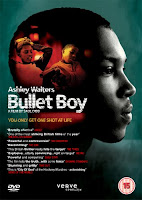 I think Columbia Pictures would distribute our media product, the reason being that they distributed a film about a psychotic ex-Vietnam veteran, called Taxi Driver (Martin Scorsese,1976). The film was not expected to be a success, and it was. This demonstrates that this institution is willing to take a chance with finances as long as they believe in the project. This is a very positive outlook to have as a media distribution as it gives their institution credibility in that they are involved with films of such a high quality. However, Columbia pictures might have changed since 1976 so I think another excellent idea for a media institution that might distribute our media product would be Verve Pictures http://www.vervepictures.co.uk/. This institution distributed Bullet Boy (Saul Dibb, 2005), a film about a family in East London torn apart coping with the eldest son’s association with gun crime. The theme of dysfunctional youths is evident in both this film and our media product. Also, Verve Pictures is an independent film company, the company statement being, “Verve Pictures is an independent UK specialist film distributor, with particular emphasis on British and independent films” which allows more room for artistic control which would suit the controversial subject matter of our thriller opening well.
I think Columbia Pictures would distribute our media product, the reason being that they distributed a film about a psychotic ex-Vietnam veteran, called Taxi Driver (Martin Scorsese,1976). The film was not expected to be a success, and it was. This demonstrates that this institution is willing to take a chance with finances as long as they believe in the project. This is a very positive outlook to have as a media distribution as it gives their institution credibility in that they are involved with films of such a high quality. However, Columbia pictures might have changed since 1976 so I think another excellent idea for a media institution that might distribute our media product would be Verve Pictures http://www.vervepictures.co.uk/. This institution distributed Bullet Boy (Saul Dibb, 2005), a film about a family in East London torn apart coping with the eldest son’s association with gun crime. The theme of dysfunctional youths is evident in both this film and our media product. Also, Verve Pictures is an independent film company, the company statement being, “Verve Pictures is an independent UK specialist film distributor, with particular emphasis on British and independent films” which allows more room for artistic control which would suit the controversial subject matter of our thriller opening well.Who would be the audience for your media product?
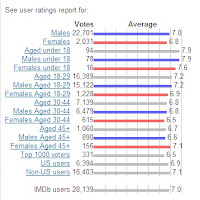 I think the audience for our media product would probably be younger people, in general, but more specifically, males in their teens to early twenties, mainly because the subject matter of our thriller would be more identifiable for people of this gender and age group. I know this from seeing the audience figures from similar films to ours, such as If... (Lindsay Anderson, 1968), which has its highest viewing figures from people aged 18-29, and then, more specifically, males aged 18-29. The same pattern can be seen with Harsh Times (David Ayer, 2006) which has the highest voting figures of 7.0 which come from males aged 18-29. The film deals with two friends, one with psychological problems, and the "violence that comes between them."
I think the audience for our media product would probably be younger people, in general, but more specifically, males in their teens to early twenties, mainly because the subject matter of our thriller would be more identifiable for people of this gender and age group. I know this from seeing the audience figures from similar films to ours, such as If... (Lindsay Anderson, 1968), which has its highest viewing figures from people aged 18-29, and then, more specifically, males aged 18-29. The same pattern can be seen with Harsh Times (David Ayer, 2006) which has the highest voting figures of 7.0 which come from males aged 18-29. The film deals with two friends, one with psychological problems, and the "violence that comes between them."I believe that the pace of our opening sequence and the fact there is a death in it would appear somewhat more to males. Also, the rest of the film would deal with a dysfunctional alienated teen, which would also appeal strongly to adolescent viewers as they could identify with it more.
How did you attract/address your audience?
One of the ways we made an effort to attract our audience was through the location of our thriller. We used a suburban house because this would be more identifiable to the male youth as this is something they are generally more familiar with. We made a conscious effort to put details into the film that are identifiable in everyday life, such as the everyday process of making a cup of coffee, or the location of the suburban house. We did this so that when the murder happens it is much more shocking and unsettling. We also addressed our audience by our idea of having a youth that is killing other youths. This is recognisable to our target audience because they are themselves mostly youths and can put themselves in the character’s positions, thoughts and emotions. The pan when the man walks through the gate up to the door achieves this. What is interesting is that the camera is always following our protagonist, as the audience is meant to empathise with him, and the antogonist is always presented with locked off, stationary shots, to detach the audience from him. The music that we used is very menacing and has a lurking presence, but despite this it is very alluring and mysterious, it attracts the audience in that they want to know more when they hear it. The idea of using turquoise coloured titles came from the opening title sequence in The Shining (Stanley Kubrick, 1980) http://www.youtube.com/watch?v=Iw23KM3-Ry8 and is meant to give a false sense of security as the colour is generally a happy, uplifting colour but in our thriller it gives a slightly off, unsettling feel.
What have you learnt about technologies from the process of constructing this product?
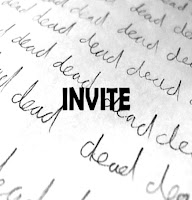 I have learned many skills and techniques about technology that were used in the making of our media product. One is the process of keeping a shot as steady as possible. To do this I put the camera on the tripod, then held it horizontally out with my arm, and then moved my hand to find the centre of gravity. This ensured that when I came to shooting the final shot of our media product, the camera was as steady as possible. Another technique that we improved on was editing. We really challenged ourselves with the intercutting of the man making the cup of coffee with the other man cautiously approaching the house. It was extremely difficult to get the rhythm of the shots just right to build the tension before the man knocks on the door of the house. We were constantly replaying the shots in Sony Vegas and cutting and stretching shots to make sure the pace was just right. We also learned how to change the volume of our music at certain points in our film, such as when as when our character speaks, the volume of the music needs to drop so we can hear him. We also learned how to make titles unique and interesting. For our titles, we took a still shot of the paper, with the word "dead" written all over it, then superimposed the titles over it. We made the title of the film enlarge, while the shot of the paper was manipulated into a camera move in Sony Vegas. I also think that it has taught us that with the technological capabilities available today, anybody and everybody can make a film if they want to. I think this is a very positive aspect of new technology because it means budding young film makers have the opportunities to experiment with cameras and editing software.
I have learned many skills and techniques about technology that were used in the making of our media product. One is the process of keeping a shot as steady as possible. To do this I put the camera on the tripod, then held it horizontally out with my arm, and then moved my hand to find the centre of gravity. This ensured that when I came to shooting the final shot of our media product, the camera was as steady as possible. Another technique that we improved on was editing. We really challenged ourselves with the intercutting of the man making the cup of coffee with the other man cautiously approaching the house. It was extremely difficult to get the rhythm of the shots just right to build the tension before the man knocks on the door of the house. We were constantly replaying the shots in Sony Vegas and cutting and stretching shots to make sure the pace was just right. We also learned how to change the volume of our music at certain points in our film, such as when as when our character speaks, the volume of the music needs to drop so we can hear him. We also learned how to make titles unique and interesting. For our titles, we took a still shot of the paper, with the word "dead" written all over it, then superimposed the titles over it. We made the title of the film enlarge, while the shot of the paper was manipulated into a camera move in Sony Vegas. I also think that it has taught us that with the technological capabilities available today, anybody and everybody can make a film if they want to. I think this is a very positive aspect of new technology because it means budding young film makers have the opportunities to experiment with cameras and editing software.Looking back at your preliminary task, what do you feel you have learnt in the progression from it to the full product?
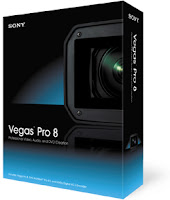
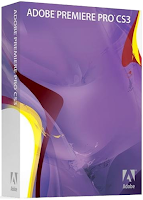 One of the main aspects of the entire film making process that I have learned is that preparation is the key to a good final product. With the preliminary task, not as much preparation was taken as there was with the thriller task, which really showed us that research into audience figures, props, locations and genre conventions really helps the production, post production and final outcome of the finished media product. I think we also learned out to give our product more of a defined storyline and plot development. Our editing also improved to the final full product, simply through practice. For the most part we used Sony Vegas for our editing, but during the final stages we used Adobe Premiere. I think it was a good thing to get experience of using two different pieces of editing software. Our preliminary task also used simple, straight cuts, while our final thriller product took advantage of dissolves, fades, flashes, and intercuts. But, overall, the process of filmmaking was developed, mastered and refined from our early fumblings in our preliminary task to our final media product.This was mainly because, with our preliminary task, we had a limited amount of time and did not really polish it off as thouroughly as we did with our thriller.
One of the main aspects of the entire film making process that I have learned is that preparation is the key to a good final product. With the preliminary task, not as much preparation was taken as there was with the thriller task, which really showed us that research into audience figures, props, locations and genre conventions really helps the production, post production and final outcome of the finished media product. I think we also learned out to give our product more of a defined storyline and plot development. Our editing also improved to the final full product, simply through practice. For the most part we used Sony Vegas for our editing, but during the final stages we used Adobe Premiere. I think it was a good thing to get experience of using two different pieces of editing software. Our preliminary task also used simple, straight cuts, while our final thriller product took advantage of dissolves, fades, flashes, and intercuts. But, overall, the process of filmmaking was developed, mastered and refined from our early fumblings in our preliminary task to our final media product.This was mainly because, with our preliminary task, we had a limited amount of time and did not really polish it off as thouroughly as we did with our thriller. Editing
After compiling our footage into Sony Vegas, me and Oliver worked on cutting the footage into a rough version of our opening sequence, focusing on the cross cutting between the colour and black and white sequences to get the pace just right to build the most tension. Zoran then focused on editing the titles into our opening sequence.
We made a cut from Oliver walking looking confused and intense straight to a shot of the boiled kettle. This cut builds the tension and implies that the boiling water is a representation of the murderer's volatile personality.
We made a cut from Oliver walking looking confused and intense straight to a shot of the boiled kettle. This cut builds the tension and implies that the boiling water is a representation of the murderer's volatile personality.
Another response we got from our rough cut was that there was too long a gap when the film fades to white. A lot of viewers thought the film was over, or their attention was lost. We then suggested the idea of splicing two flash ons of an image of a gun. This represents the murder which is occuring during these moments and also creates mystery within the audience.
For the shot of the gate closing, me and Oliver chose to cut to the next shot when the sound of the gate closing crashes. This connects the gate shot and the next in a good way because it resolves the first, so it goes seemlessly with the next. The sound also crescendos, just like at other points in the film, such as the end where the sound increases, then crashes to silence. We used this similar technique of the sound effect leading to the next shot, with the shot of the man placing his coffee mug on the worktop.
Overall, we learned a lot about editing making this opening sequence. I had some basic knowledge of editing but this task really put me to the test, and I anticipated it would with the complicated process of cross cutting.
Filming
First Shoot:
Me, Zoran and Oliver began our first and main shoot on a Tuesday when we were all free. Zoran helped me with some of the shots but I filmed the bulk of the shots which contain Oliver, and he filmed the scenes which I am in, however I filmed the final shot. We were always making sure that the framing and steadiness of the shots was as impeccable as possible. Using our storyboard as our guide, we achieved a certain shot and then ticked it off on our storyboard sheets. We went along doing this until we had completed filming. It took roughly about two hours to shoot the shots we needed. We all preferred the quick, sponateous film making method as we felt quite confident with all the preparation we had made.
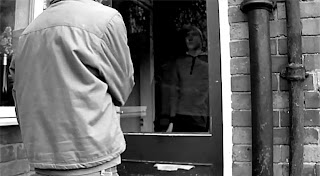 The main highlight of the shoot was achieving a shot that was not really planned at all but one that we took advantage of when we relaised its potential. It is the shot where Oliver is stood, waiting at the door for an answer. We knew his reflection could be seen in the door window and Oliver had the idea of me, answering the door, and stepping into the reflection from behind the glass. I thought it gave the antagonist of our thriller a creepy, menacing side. On another note, it might be a subtle suggestion on a second viewing of the film, that this character is distinguishing his victim's reflection just before he finally distinguishes his life.
The main highlight of the shoot was achieving a shot that was not really planned at all but one that we took advantage of when we relaised its potential. It is the shot where Oliver is stood, waiting at the door for an answer. We knew his reflection could be seen in the door window and Oliver had the idea of me, answering the door, and stepping into the reflection from behind the glass. I thought it gave the antagonist of our thriller a creepy, menacing side. On another note, it might be a subtle suggestion on a second viewing of the film, that this character is distinguishing his victim's reflection just before he finally distinguishes his life.
Me, Zoran and Oliver began our first and main shoot on a Tuesday when we were all free. Zoran helped me with some of the shots but I filmed the bulk of the shots which contain Oliver, and he filmed the scenes which I am in, however I filmed the final shot. We were always making sure that the framing and steadiness of the shots was as impeccable as possible. Using our storyboard as our guide, we achieved a certain shot and then ticked it off on our storyboard sheets. We went along doing this until we had completed filming. It took roughly about two hours to shoot the shots we needed. We all preferred the quick, sponateous film making method as we felt quite confident with all the preparation we had made.
 The main highlight of the shoot was achieving a shot that was not really planned at all but one that we took advantage of when we relaised its potential. It is the shot where Oliver is stood, waiting at the door for an answer. We knew his reflection could be seen in the door window and Oliver had the idea of me, answering the door, and stepping into the reflection from behind the glass. I thought it gave the antagonist of our thriller a creepy, menacing side. On another note, it might be a subtle suggestion on a second viewing of the film, that this character is distinguishing his victim's reflection just before he finally distinguishes his life.
The main highlight of the shoot was achieving a shot that was not really planned at all but one that we took advantage of when we relaised its potential. It is the shot where Oliver is stood, waiting at the door for an answer. We knew his reflection could be seen in the door window and Oliver had the idea of me, answering the door, and stepping into the reflection from behind the glass. I thought it gave the antagonist of our thriller a creepy, menacing side. On another note, it might be a subtle suggestion on a second viewing of the film, that this character is distinguishing his victim's reflection just before he finally distinguishes his life.Re-shoot:
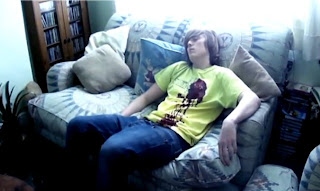 Reshooting the final shot was an effective way of killing two birds with one stone, in that we would correct the shaky camera, and add blood into the shot. It was decided that me and Oliver would film the reshoot as Zoran was not available at that time. We used red food colouring on Oliver's t-shirt and ketchup to give the blood a thick look. One of the main reasons the original shot was shaky was because the battery was low and were rushing to get the shot done before it died. With this in mind on the day of the re-shoot, I brought my fully charged camera, and secured it tightly to the tripod, to ensure no accidental camera shake. Oliver got in his position on the sofa, and I began to film the final shot again, concentrating most on keeping the camera as smooth as possible. It took a few tries, but we eventually achieved a shot we were both quite pleased with. When I put this shot into Sony Vegas to replace the orignal shot, I had to change the colour correction on the shot to give it as close a resemblance to the original shots as possible.
Reshooting the final shot was an effective way of killing two birds with one stone, in that we would correct the shaky camera, and add blood into the shot. It was decided that me and Oliver would film the reshoot as Zoran was not available at that time. We used red food colouring on Oliver's t-shirt and ketchup to give the blood a thick look. One of the main reasons the original shot was shaky was because the battery was low and were rushing to get the shot done before it died. With this in mind on the day of the re-shoot, I brought my fully charged camera, and secured it tightly to the tripod, to ensure no accidental camera shake. Oliver got in his position on the sofa, and I began to film the final shot again, concentrating most on keeping the camera as smooth as possible. It took a few tries, but we eventually achieved a shot we were both quite pleased with. When I put this shot into Sony Vegas to replace the orignal shot, I had to change the colour correction on the shot to give it as close a resemblance to the original shots as possible.
The one and only reshoot we did was based on some audience responses that we got back from people seeing a rough cut of out film. Some people said they really liked the "lurking presence" of the shot at the end of the film, but felt that the end of the shot, where the body of the man is revealed lying dead on the sofa, is too shaky. We all had to agree and felt that this was one shot that it was essential to re-shoot. Some other critical feedback mentioned that it was not really clear that the man was dead, and that they would have liked to have seen more blood to confirm this.
 Reshooting the final shot was an effective way of killing two birds with one stone, in that we would correct the shaky camera, and add blood into the shot. It was decided that me and Oliver would film the reshoot as Zoran was not available at that time. We used red food colouring on Oliver's t-shirt and ketchup to give the blood a thick look. One of the main reasons the original shot was shaky was because the battery was low and were rushing to get the shot done before it died. With this in mind on the day of the re-shoot, I brought my fully charged camera, and secured it tightly to the tripod, to ensure no accidental camera shake. Oliver got in his position on the sofa, and I began to film the final shot again, concentrating most on keeping the camera as smooth as possible. It took a few tries, but we eventually achieved a shot we were both quite pleased with. When I put this shot into Sony Vegas to replace the orignal shot, I had to change the colour correction on the shot to give it as close a resemblance to the original shots as possible.
Reshooting the final shot was an effective way of killing two birds with one stone, in that we would correct the shaky camera, and add blood into the shot. It was decided that me and Oliver would film the reshoot as Zoran was not available at that time. We used red food colouring on Oliver's t-shirt and ketchup to give the blood a thick look. One of the main reasons the original shot was shaky was because the battery was low and were rushing to get the shot done before it died. With this in mind on the day of the re-shoot, I brought my fully charged camera, and secured it tightly to the tripod, to ensure no accidental camera shake. Oliver got in his position on the sofa, and I began to film the final shot again, concentrating most on keeping the camera as smooth as possible. It took a few tries, but we eventually achieved a shot we were both quite pleased with. When I put this shot into Sony Vegas to replace the orignal shot, I had to change the colour correction on the shot to give it as close a resemblance to the original shots as possible.Also worth mentioning, is the fact that we changed the prop of the gun. When we came to the re-shoot, we could not find the gun we used in the original footage, so we had to use another one that we could find. To the left is the gun that we eventually used.
Friday, 1 April 2011
Music
We discovered a website, where you can download royalty free music, free of charge, called Jamendo.com: http://www.jamendo.com/en/.
We searched "soundtrack" and looked through some of the music on there to see which would suit our film the best. We decided on a piece by musician Daniel Catarino, on his album "O Rio e o Moleiro", called "Lia e o Moleiro". We thought this would be a very good track to use as the music builds up and is very menacing and represents the nature of the character within the house and foreshadows the death that is to come.
It then came to editing the music into our opening sequence. We used Adobe Premiere to change decrease the volume of the music at certain stages, for example, when there is dialogue. I also made the music audio rise at the end, when the title of the film, "Invite" appears, then crescendo to silence. This gives an eerie, lurking presence to the music.
We searched "soundtrack" and looked through some of the music on there to see which would suit our film the best. We decided on a piece by musician Daniel Catarino, on his album "O Rio e o Moleiro", called "Lia e o Moleiro". We thought this would be a very good track to use as the music builds up and is very menacing and represents the nature of the character within the house and foreshadows the death that is to come.
Subscribe to:
Comments (Atom)






